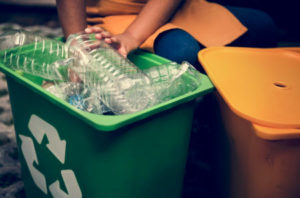All About HDPE Recycling
About HDPE Recycling
One of the biggest selling points of HDPE (high-density polyethylene) plastic partitions and lockers is that they are sustainable. Not only can they be made from recycled material, but they’re easily recycled and reused. Facility managers understand the need for sustainable building products, as well as the benefits of choosing such products for their facility. However, a lot of people want to know how HDPE is recycled.
How is HDPE Recycled?
There are different stages of HDPE plastic. While you’re familiar with the material for partitions and lockers, HDPE can also be found in containers, non-corrosive piping, and even plastic bottles. Each material has their unique properties, but all of it can be recycled and transformed into other HDPE plastic products.
 When recycled, HDPE is generally separated by grade since some HDPE plastic is thicker and more durable than others. All the plastic is rigorously cleaned to remove any particles or debris, so only the HDPE materials can be homogenized and processed. By removing any foreign debris and cleaning the plastic, HDPE is safe to continue with its recycling. Any particles left in will essentially ruin the end products.
When recycled, HDPE is generally separated by grade since some HDPE plastic is thicker and more durable than others. All the plastic is rigorously cleaned to remove any particles or debris, so only the HDPE materials can be homogenized and processed. By removing any foreign debris and cleaning the plastic, HDPE is safe to continue with its recycling. Any particles left in will essentially ruin the end products.
HDPE then goes through a granulation process, which takes larger pieces of HDPE plastic and shreds it down, or melts it into pellets and granules for later use. This process will take the pellets and granules and combine or reshape them through several processes in order to create a new product using the same plastic that was originally recycled.
The Sustainable & Eco-Friendly Benefits of Recyclable HDPE Plastic
Given the durability of HDPE plastic, and how easily it can be recycled and reused in a variety of materials, makes it one of the more versatile building materials on the market. Today, sustainability is an important factor that a variety of industries need to consider not only to improve their impact on the environment, but also to reduce the amount of unnecessary waste. HDPE plastic can be reused and recycled again and again, making it a reliable, efficient, and long-lasting product that has endless applications. Choosing HDPE plastic is the smarter and greener choice towards sustainability.
HDPE Contributes to Well v2 and LEED v4.1 credits
Scranton Products® provides LEED v4 and LEED v4.1 documentation, leading to a safer, greener, cleaner and more energy efficient environment within the building where they are applied. Scranton Products® brands help contribute points to LEED (Leadership in Energy and Environmental Design) certification for your building LEED is internationally recognized as a “green” building certification.
Want to learn more about the sustainability of HDPE plastic and how it can improve your facility? Check out this free eBook, Sustainable Building Products: How to Make Your Facility Eco-Friendly from Top to Bottom, from your friends at Scranton Products.



